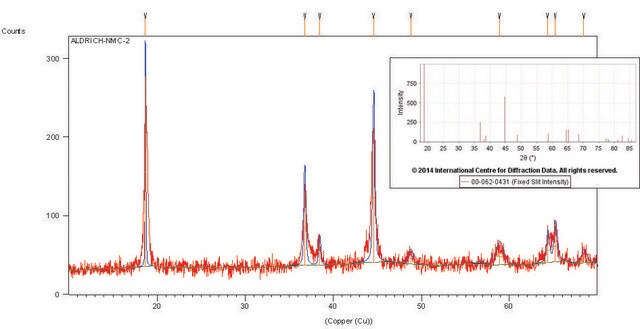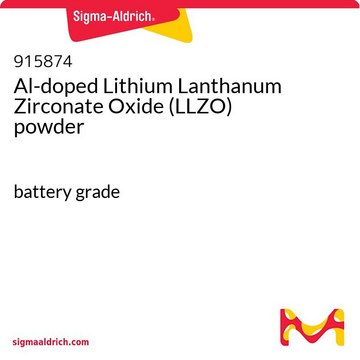759546
Lithium iron(II) phosphate
powder, <5 μm particle size (BET), >97% (XRF)
Sinônimo(s):
Ferrous lithium phosphate, Iron lithium phosphate, LFP, Triphylite
About This Item
Produtos recomendados
grau
battery grade
Nível de qualidade
Ensaio
>97% (XRF)
Formulário
powder
peso molecular
Mw 157.76 g/mol
composição
LiFePO4
características do produto alternativo mais ecológico
Design for Energy Efficiency
Learn more about the Principles of Green Chemistry.
sustainability
Greener Alternative Product
tamanho de partícula
<5 μm (BET)
pf
>300 °C (lit.)
densidade
3.6 g/cm3 (lit.)
aplicação(ões)
battery manufacturing
categoria alternativa mais ecológica
cadeia de caracteres SMILES
[Fe+2].[Li+].[P](=O)([O-])([O-])[O-]
InChI
1S/Fe.Li.H3O4P/c;;1-5(2,3)4/h;;(H3,1,2,3,4)/q+2;+1;/p-3
chave InChI
GELKBWJHTRAYNV-UHFFFAOYSA-K
Procurando produtos similares? Visita Guia de comparação de produtos
Categorias relacionadas
Descrição geral
Aplicação
Características e benefícios
✔ Achieves 1000s of cycles
✔ Safer than cobalt or manganese-based cathode materials
✔ Reliable performance
Informações legais
produto relacionado
Código de classe de armazenamento
11 - Combustible Solids
Classe de risco de água (WGK)
WGK 1
Ponto de fulgor (°F)
Not applicable
Ponto de fulgor (°C)
Not applicable
Escolha uma das versões mais recentes:
Já possui este produto?
Encontre a documentação dos produtos que você adquiriu recentemente na biblioteca de documentos.
Os clientes também visualizaram
Artigos
Professor Qiao’s laboratory lays out recent advances in conversion type lithium metal fluoride batteries. This review explores key concepts in developing electrochemically stable microstructures for wide Li-ion insertion channels.
Electrode Materials for Lithium Ion Batteries
Lithium-ion batteries (LIBs) have been widely adopted as the most promising portable energy source in electronic devices because of their high working voltage, high energy density, and good cyclic performance.
The critical technical challenges associated with the commercialization of electric vehicle batteries include cost, performance, abuse tolerance, and lifespan.
Global Trade Item Number
| SKU | GTIN |
|---|---|
| 759546-5G | 4061832916958 |
Nossa equipe de cientistas tem experiência em todas as áreas de pesquisa, incluindo Life Sciences, ciência de materiais, síntese química, cromatografia, química analítica e muitas outras.
Entre em contato com a assistência técnica










